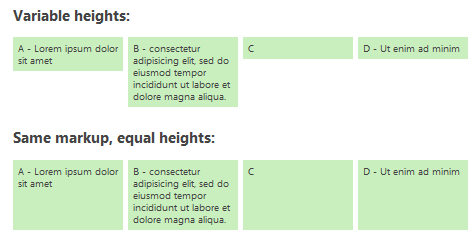

The first step is to set the height of the parent div to auto. CSS can be used to set the height of divs, and it can also be used to make the inner divs the same height as the parent div. CSS stands for Cascading Style Sheets, and it is a language used to style web pages. Using CSS to Make Inner Divs the Same Height as Parent Divsįortunately, there is a way to make the inner divs the same height as the parent div, even when the parent div has an auto height. This can be a problem if you want the inner divs to have the same height as the parent div. In this case, the inner divs will not automatically have the same height as the parent div. This means that the height of the div is determined by the content inside it. In some cases, however, the parent div may have an auto height. When a div is nested, the inner divs will usually have the same height as the parent div. This is useful for creating complex layouts. Divs can be nested, meaning that one div can contain another div. Divs are also used to create responsive designs, which means that the design will adjust to different screen sizes. They are often used to create columns, rows, and other types of layouts. After that, you can easily set the width and height of the span.Making Inner Divs the Same Height as Parent Divs with Auto Heightĭivs are a type of HTML element that are used to divide a web page into sections. Which we can do using the display property. So, if we want to set the width and height of a span element, we have to first change its display type to either inline-block or block. Which is why the width and height properties become ineffective. The span is an inline element and only takes up as much space as it requires to fit its content. In this article, we learned why the width and height properties do not work on a span element and how can we make them effective. *Set width and height of span*/Īfter running the above code, you will get the following output:

To set its width and height, apply display: block and then use the width and height properties. Let’s say we have the following span in our HTML document: This is a span element. So, if you set the display property of the span element to block, the width and height properties become effective.

Such elements also support the width and height properties.
#AFTER SAME HEIGHT AS ELEMENT CSS FULL#
If you set an element’s display property to block, by default, it takes up the full width of its parent element irrespective of the content it has. Use display: block to Make Width and Height Effective Now, set its display property to inline-block and apply the width and height properties. Let’s say we have a span element in our HTML document and we want to give it a width of 300px and height of 100px: This is a span element. So, to set the width and height of a span element, we will first change its display type to inline-block using the display property and then apply the desired width and height. The inline-block elements do also not start on a new line like the inline elements, but they do support the width and height properties. So, if we anyhow want to give the width and height to a span, we have to change its default display type and set it to either inline-block or block. This is because the paragraph is a block-level element whereas the is an inline-level element.Īs previously said, the is an inline-level element, therefore it does not support the width and height properties. Whereas, the paragraph element takes up the full width of its parent element even if that much space was not required to fit its text. An inline element does not start on a new line and only takes up as much space as required.Īs you can see from the above image, the span element only takes up as much space(width) as required to fit its text. The reason why the width and height properties do not affect a element is that the element is an inline element.

But, you might have at least once faced a problem where you need to set the width and height of a but it didn’t work. When building a website, we often need to set the width and height of elements to fit them in the layout.


 0 kommentar(er)
0 kommentar(er)
